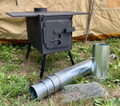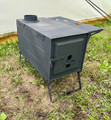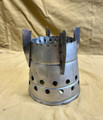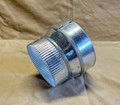 Loading... Please wait...
Loading... Please wait...- Home
- Stove Selection Tips
6 Helpful Tips to Finding the Right Tent Stove
Finding the right tent stove is critical to your comfort in the bush, and it's worth spending time thinking about what you need your stove to do, and how you plan on using it.
What I'd like to do is give you a headstart on finding a stove that will work reliably, and without any hiccups, when you are out on the trail.
Based on my tried-and-tested experience, I'll show you how to look for features that you'll want to have in your stove, how to set up your stove, and how to find the best stove based on what you plan on doing with it.
Here are the 6 key features I'd suggest you consider when looking at a new stove--which I'll explain in more detail for each item, below:
- Weight: Finding the right stove that hits your sweet spot between weight and utility for your needs
- The Stove Door: What to look for in a stove door and why this matters to you
- Fit and Finish: What to look for quickly to determine the quality of your potential new stove
- Positioning the stove: Discover where to place the stove for the best heat and safest use
- Safety: Tips to staying safe and sound with your new stove
- Fun facts about fuel: Discover facts and figures that make you a better fire keeper
1. Weight
Weight in regard to stoves, is determined by the weight of the material from which that stove is made (steel vs. titanium, for example) as well as from the size of the stove.
What weight stove do you need?
For some people, shopping for a stove by "weight" seems like a reasonable way to choose a stove, especially if you hand-haul or pack your stove in with dogs or pack animals.
Weight alone is not necessarily the best way to select a stove, and I'll tell you why that's the case.
Do you realy need a light weight stove?
For starters, some of the lighter weight tent stoves on the market today lack the safety features and user-friendly functions that make heavier stoves an often better choice.
- Lighter stoves are lighter because they are either:
- Smaller (in terms of dimensions)
- Made from thinner gauge materials (in the case of steel stoves)
- Made from lighter materials (such as Titanium)
- Or a combination of these three factors
- Some manufacturers use thinner gauge materials to make their steel stoves lighter. This can be a dangerous practice. When your materials get too thin, you run a higher risk of burning through your stove, warping it and having it fail to perform in severe conditions. This can be dangerous at best, and deadly at worst.
A lighter stove may produce less heat than you need in your tent to be comfortable if the weather turns colder--and in a worse case scenario, can cause a tent fire or other potentially damaging situation when you least expect it, if the stove "fails".
Options for selecting a safe, lighter weight tent stove
Failure to perform, and an increased risk of fire hazard are the main reasons why I refuse to make cheap stoves, or cut corners to cut down weight, because doing that would increase the risk of danger to you--and that is unacceptable to me.
In order to deliver a lighter weight stove, without compromising safetly, I created two smaller sizes of my steel stoves (the Two Dog DX Camp Stove and Three Dog DX Camp Stove models), and build a line of Titanium stoves, as well.
The Titanium Woodburning Stoves in the Four Dog line up, are lighter and more durable than steel of the same gauge, can tolerate higher temperature fires (3,200 F vs 2,600 F melting point when compared to steel), and are extremely lightweight.
The Titanium Ultra Light I-DX for example, weighs just 10 pounds, is 200 times more resistant to corrosion than steel, is tougher than steel, and can tolerate higher heat.
The Titanium Ultra Light I ti Camp Stove is lighter still (at 8.0 pounds) and heats a 8' x 10' tent in minus degree weather. Worth a look, if weight is a critical factor for you. By the way, this stove is very popular with fur trappers in Northern Canada--where durability and heat are necessary to survival!
If getting a lighter weight stove is important for you (or if you have a smaller space to heat), then you should take a look at the Two Dog Tent Stove.
- The Two Dog DX Tent Stove is the lightest steel model I make (at just 38 pounds) and is meant for heating a space up to an 8' x 10' tent in sub-zero weather.
- The Two Dog DX Tent Stove is made to thrive under heavy use, using the same welded heavy-gauge hot-rolled steel constuction, and airtight fiberglass-gasket doors that I use in all my stoves, guaranteeing you stay warm and safe, on all your wilderness excursions.
The Two Dog DX Tent Stove creates warming heat for cooking and comfort in your tent, without the risk of burning through or failing you when you need to rely on it the most.
If you want to go ten pounds heavier, the Three Dog Stove (48 pounds) will heat a 10'x 12' wall tent, while giving you more heating and cooking capacity, for larger camp parties that still want to travel light, or be on the move.
Heavier Tent Stoves for Extra Durability
When you get into the larger stoves, like the Four Dog DX Camp Stove and Five Dog DX Camp Stove models, you'll get into stoves that weight between 55 and 75 pounds--capable of heating up to a 16' x 24' wall tent in minus degree weather.
You'll get the same quality in all my stoves, it's just that these larger models are best suited for heating larger spaces, and tending to the heating and cooking needs of more campers.
I have many customers who want the size and convenience of a larger stove, but need to keep their stove weights to a minimum. If you are in this same boat, then I'd recommend you take a close look at the Titanium Ultra Light II or Titanium Ultra Light I-DX
When you get into the larger stoves, like the Four Dog DX Camp Stove and Five Dog DX Camp Stove models, you'll get into stoves that weight between 55 and 75 pounds--capable of heating up to a 16' x 24' wall tent in minus degree weather.
You'll get the same quality in all my stoves, it's just that these larger models are best suited for heating larger spaces, and tending to the heating and cooking needs of more campers.
I have many customers who want the size and convenience of a larger stove, but need to keep their stove weights to a minimum. If you are in this same boat, then I'd recommend you take a close look at the Titanium Ultra Light II or Titanium Ultra Light I-DX
The Right Stove & the Right Fire
No matter which size stove you need for your winter comfort, it's important to get the fire burning hot and clean.
Here's a helpful video showing you some of the fire builiding and wood stove heating tips I've picked up over the years. These pointer seem to work best for me (and produce steady heat in my stoves) and might be useful to you, too:
How to build a clean burning fire in your stove:
2. The Stove Door
It's important to look at the door of any new stove you are considering, since it is very important that you get the right stove door design.
As simple as it sounds, the door can make or break your stove. You absolutely need to pay attention to the details of the stove door, when shopping for a new tent stove.
First of all, look for a high quality, tight-sealing door--and in the best doors, this seal will be an airtight seal. An airtight seal is important because it gives you the most control over your fire, and adds years of life to your stove, as it prevents overheating and reduces warping.
Not only is the door design critical to your safety, the door is vital to the quality of flame your stove will generate.
The door design helps you burn cleaner, hotter and more efficiently. For this reason, I build all my stove doors with airtight fiberglass-gaskets and spark arresters, to keep you safer, and let you burn a cleaner flame, for added heat and comfort.
Let's take a closer look at why the stove door design is so important, and what it does for your stove, and comfort, in the field:
Get a Heavy Door That Seals Airtight
For good combustion of your fuel, your stove door needs to create and airtight seal.
An airtight seal prevents excess air from leaking into the firebox, and lets you control the airflow into the stove.
Cheap, poorly made doors allow air "leakage" into the stove, which can warp and create airflow gaps--this means you quickly lose control over regulating the size and intensity of your fire--increasing your risk of fire danger and chance of injury.
Tightly sealed doors (using fireproof fiberglass rope or similar sealing materials), with solid latches let you seal the door tight, to control the flame and heat output.
Controlling your fire is extremely important. If you cannot control your flame (damper down for a slow burn, or rev the flame up for quick heat), you are running a dangerous stove.
A good door will let you keep the temperature of your tent at a comfortable, steady level for long periods of time.
In the worst case, a poor door will allow too much draft into the firebox, which can overheat your stove and burn your tent down at 3:00 a.m. when it's - 20 F outside. Not good!
Cleaner Burning Fuel
A properly designed stove door will also help your fuel burn cleaner, because you can control how much oxygen mixes with the gasses being driven off the wood, improving combustion and controlling your heat.
Remember, the dryer the wood you are burning, the better. Also keep in mind, wood does not become fuel until is burned down to charcoal. In order to get the wood to charcoal, you have to burn off the moisture and resin in the wood until you get a "no smoke" fire going in your stove.
The best way to reach charcoal fastest is to choose dry wood, follow good fire starting procedures, and use your door to help you regulate airflow. Again, a good door, that is properly designed, will make starting youre fire (and burning cleanly) a more enjoyable experience for you.
You Need Turbulence
This is the last critical role your stove door plays in the fire making process.
A good door design will create turbulent air flow that allows the hot gasses to mix in the firebox, re-combust and improve your flame.
You'll know that you are burning a clean, hot fire when there is no smoke coming from your stove pipe--all you'll see is shimmering air, where the heat is rising from your pipe. White smoke is common when you first start your fire or add new fuel to your stove, as this is water vapor evaporating from the wood. If you see blue smoke, or dark smoke from your stove pipe, you are burning inefficiently, and need to adjust your turbulence, air ports or open your door a bit, to get your fire burning hot again.
You'll see that all my Four Dog stove doors are constructed with airtight fireproof fiberglass gaskets, with a solid-seated latch, and adjustable air intake ports (with spark arresters) to give you complete control over your fire--increasing your comfort, safety and ease-of-use in the bush.
3. Fit and Finish
Look at the overall fit and finish of any potential new stove, before you buy it.
You have to ask yourself if this is the kind of stove--in quality, design and reliability--that you can trust with your life.
And that's no exaggeration--you need to know that you can trust your life to this stove, since in harsh conditions in the bush, your life may indeed depend upon this stove.
If you use your stove in a cloth tent, you really do trust your life to it, since one wrong spark or split weld can spell complete disaster, injury (or even death). You wouldn't drive a car without brakes, so please don't use a stove without adequate safety features.
Here's what you'll want to look at when considering a new stove:
Does the stove have a true airtight door?
If it does not have a high temperature gasket on the door, it is not air tight.
All my Four Dog tent stove doors are constructed with durable materials, spark arresters and airtight seals, to ensure you get the hottest, cleanest (and safest) burn possible.
Baffled Airflow for Cooking and Safer Use
Does the stove have a baffle to prevent flames from directly going up the stove pipe?
A baffle adds to safety, efficiency and durability of your stove, by spreading the flame evenly across the top of your stove--which is great for cooking--and it also prevents the flame from going directly up the stove pipe. A direct flame up the stove pipe can be a fire hazard in the making.
You'll notice that all the stoves we make have a baffle that prevents the flame from directly reaching the stove pipe. As a result, more heat is distributed along the entire firebox of your stove, resulting in more radiant heat from the same amount of fuel--and a more evenly heated surface you can use for cooking (or boiling water).
Control Your Fire by Dampering
Can you damper your stove to a low flame, without smoke coming from the seams?
If you close the damper on your stove, and smoke comes from the seams,it is a sure sign that your stove will suck air at the worst times, creating a fire hazard when you are least prepared to deal with it (which is most likely at night, in minus degree weather).
4. Positioning Your Stove in Your Tent
Where you position your stove in your tent often goes by the culture of doing it "how your daddy did it", without really asking if that's the best way to do it.
I’ve have found the best position for a stove is as close to the center of tent as possible.
Why?
Well, the sun is at the center of our Universe, and radiates heat out from the center, which is a model many indigenous people throughout history followed, when heating their dwellings.
Look at the North American tepee, the Mongolian yurt, or the Lavu used by Nordic cultures: Each of these structures places the fire in the center of the dwelling.
Presently, the Swedish, Finnish and Norwegian military all use there stoves in the center of the tents, as it allows for better draw on the stove pipe, more radiant heat off the metal of the stove pipe (before the hot gases leave the pipe) and better heat distribution throughout the tent.
From my experience, placing your stove in the center of the tent, results in even heat throughout your tent--so it's not too hot in one corner and cold in the far corner (which can happen with corner-placed stoves).
No matter where you decide to put your tent stove, remember that proper clearances from combustibles must always be observed.
You should have a minimum of 24” all the way around your stove, on all sides.
If you are getting singed inserts or damaged canvas on your tent, you are too close to your tent...or you have poor insert placement. Always check your inserts and stove placement, and get in the habit of checking your clearances as you use the stove.
It's often the case that items get moved closer to the fire, as you settle into camp, and you want to avoid any unintended fire hazards by maintaining that 24" clearance.
5. Tips to Help You Safely Enjoy Your Tent Stove
The simple truth is, you cannot be too safe when using your tent stove in the bush.
The good news is, it only takes a little bit of awareness on your part to safely enjoy the warmth, comfort and convenience that your tent stove can provide for you and your camp.
Just like any piece of equipment, the best made stove can fail due to "Operator Failure", which is important to keep in mind.
This means that you should spend time with your stove, learning its "ins-and-outs" when you can spend uninterrupted time, learning how to get the most from your stove--so you can get the most out of it, when you most need it.
In today's "push button" world, we don't often spend time working with our gear to find out its sweet spot, or how to get the most of it.
Spend time tinkering with your wood stove, to learn how to best start a fire, what combination of settings give you a slow burning fire, and what warning signs your stove gives you when you are pushing it too hard.
Burning wood is a bit of an art, and requires you to work within laws of physics that must be observed to get the best results. You have to have the right kind of fuel, a good airflow, a good door and some patience to really master your fire starting skills. And that's the fun part of it--you get better as you practice, and soon it becomes second-nature to get a nice warming fire going, whenver you need one.
I'd say a tending a tent stove is a lot like tending a good mule-- the more you take care of its needs, they better it will work for you.
And like a mule, if you mistreat your stove (shove it full of green wood, or burn it too hot), then you won't want to turn your back on it...because its liable to kick ya!
It's up to you to learn the magic of your stove, to get it to do its best work.
Spend time in your back yard, working your stove, so you'll know how to get the most out of it in the bush.
Soon you'll be working your stove, tending your fire, and creating good memories that will warm your heart for years to come.
Over the years, a good stove keeps not only keeps you warm, and cooks your food, it can save your life--and give you a lifetime of happy stories that last for generations.
6. Fun Facts About Wood--and how to be a Better Firekeeper!
- One pound of dry wood material contains 7,000 btu of energy
- A stick of dry-seasoned wood will contain 16% water, on average
- Dead laying wood, found horizontal on the ground, will contain from 40 to 60% water (or more)
- Green wood contains from 40-60% moisture (or more) as a general rule
Note: If a pound of dry wood contains 7,000 btu’s, then the higher the water content in the wood, the more energy (in btu's) you'll need to dry the wood "on the go" and convert wet or green wood, into useable fuel. This is what reduces wet wood's efficiency, compared to dry wood.
- Dead standing wood, with the bark off, is the best fuel to find.
- Any horizontal angle on the tree will add 1% water for every 1% angle.
- 6-8 inch diameter wood will allow you to get a good fire started--thus allowing you to use less desirable wood with a higher water content, once your coal bed is established.
- "Efficiency" means how much usable energy you extract from your wood.
- If you burn your stove at 30% efficiency or at 60%, the difference means you must cut , haul and stock the fire twice as much at 30% compared to 60%.
- Poor wood selection for fule means twice the work, and half the fun.
- Small wood good. Big wood bad.
- The little bit of extra effort it takes to cut and split the wood pays of with a better burn and less work in the long run.
- For every 1% mositure increase in wood (from the dry wood average of 16%) you'll see a 2% drop in efficiency
- The larger the wood, the more energy required to cure the wood--or in other words the harder it is to get the water and resin out of the wood to make fuel.
- One pound of dry hardwood will contain as much heat value as pound of pine, with the difference being in volume of each wood required. Pine will take twice as much room as oak in volume. So the same fire box filled with oak will give twice as much heat as the same fire box filled with pine.
- Blue smoke is a sure sighs of a poor burn and poor fire technique.
- Blue smoke is unburnt gases and energy leaving your stove, resulting from burning a cool fire or placing new wood that is too large, onto small a coal base.
- Blue smoke creates creosote in the pipe, requiring frequent pipe cleaning.
- You should have only two colors of smoke: white smoke and "no smoke".
- White smoke is normal when starting a fire, or when adding new wood to an established coal bed.
- White smoke is a mixture of gasses and water vapor leaving the wood, when in contact with a flame.
- "No Smoke" means you see heat rising from your stove pipe (shimmering air), but do not see visible smoke.
- No smoke, or clear smoke, means you are burning all the energy being released from the wood before it leaves the pipe.
- Always rake your coals forward on a new fueling, because this give you the heat you need to make that new wood into charcoal.
- Learn and perfect you fire skills, it will help you amaze your friends and family . Who knows it may save your life or that of a love one and at least it will help you enjoy
- Remember: If we do something wrong for thirty years, and keep doing it that same way for another thirty years--it still doesn't make it right.
Stay warm and keep your traces tight!
-D. Kevilus
Four Dog Stoves
Current Top Sellers
-
1
-
2"Big Dog"$385.00

-
3
-
4"Little Dog"$300.00

-
5

















